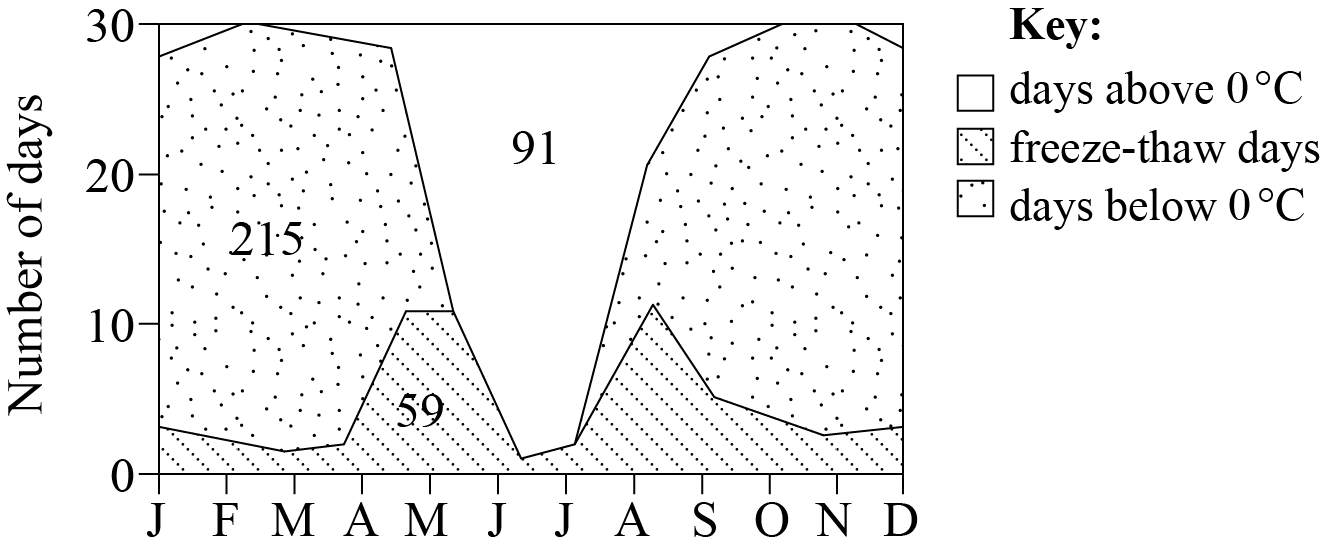| Date | November 2012 | Marks available | 6 | Reference code | 12N.2.bp.6 |
| Level | SL and HL | Paper | 2 | Time zone | |
| Command term | Explain | Question number | 6 | Adapted from | N/A |
Question
The diagram shows temperature conditions for a year in a periglacial region of the northern hemisphere.

[Source: H French, The Periglacial Environment, Longman, (1996), page 24]
Define the term freeze-thaw.
Describe the seasonal variations in the number of freeze-thaw days.
Explain the importance of freeze-thaw cycles and solifluction processes for the development of periglacial landforms.
Examine how the physical characteristics of any one extreme environment (glacial, periglacial, or hot, arid) affect resource development.
Markscheme
The freezing and subsequent thawing of water / when temperature rises above and falls below freezing/0°C [1 mark].
There appears to be two peaks (bimodal): one in late spring and one in Fall/Autumn [1 mark]. There are fewer in the summer and also in winter [1 mark]. Credit attempts at quantification or any other significant detail [1 mark].
A list of monthly data should receive no more than [2 marks].
Award up to [4 marks] for an explanation of how either process is linked to the development of one or more landforms. For instance, freeze-thaw (and associated frost heave) play a key role in the development of patterned ground and pingos (could also include tors or aspects of thermokarst). Solifluction is likely to be linked with patterned ground (also possibly lobes, terracettes). For the award of the full [6 marks], both processes should be included and related to the landform(s).
For a periglacial environment, the characteristics are likely to include climate, permafrost, hours of daylight, length of winter, waterlogging, poor soils and subsidence (thermokarst). There are also a number of hazards such as avalanches, rock falls, icings and frost heave. These make resource development such as mining and associated infrastructure construction difficult. Services need to be provided in insulated pipes called utilidors. Waste disposal is difficult because of the low temperatures. Credit other ideas, for instance, management or risks associated with resource development, e.g. oil spills are broken down very slowly in cold temperatures; or ideas about farming / tourism / nature of ecosystem services.
A similar approach is valid for the other extreme environments. For glacial environments, the physical characteristics might include altitude, gradient, temperatures, depth of snow/ice, annual snowfall, speed of glacial movement, ablation, etc.
For hot, arid environments, the characteristics might include water availability (aquifers, oases), evaporation, type of surface (sand, rock, pebbles), gradient, temperature range (diurnal/seasonal) etc.
To access band E and above, answers should refer to named examples.
For answers examining more than one extreme environment, only the highest-scoring environment should be credited.
Marks should be allocated according to the markbands.
Examiners report
The definition was covered adequately.
Too many candidates failed to recognize the importance of mentioning changes in temperature or identifying freezing point, merely stating it was a cycle of freezing and melting in winter and summer.
Responses did not often relate the process of freeze-thaw to the landforms named and in fact knowledge of periglacial landforms was sketchy.
The periglacial environment was the most popular extreme environment chosen. Resource development was well exemplified using the Trans-Alaskan pipeline at the expense of looking at a range of physical characteristics. The factors tended to be described rather than analysing the link.

